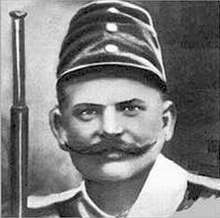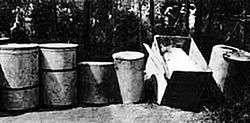Béla Kiss
Béla Kiss (/kɪʃ/; Hungarian: [ˈbeːlɒ ˈkiʃ]; 28 July 1877 – after 4 October 1916) was a Hungarian serial killer. He is thought to have murdered at least 23 young women and one man, and attempted to pickle their bodies in large metal drums that he kept on his property.
Béla Kiss | |
|---|---|
 Sketch of Béla Kiss | |
| Born | Kiss Béla c. 1877 |
| Disappeared | October 4, 1916 |
| Died | After October 4, 1916 |
| Spouse(s) | Júlia Peschadik (1905/1906–?) Mária ? (?–1912) |
| Children | Aranka Ilonka |
| Parent(s) | János Kiss Verona Varga |
| Conviction(s) | Never convicted |
| Details | |
| Victims | 24+ |
Span of crimes | 1900–1914 |
| Country | Hungary |
Date apprehended | Never apprehended |
Background
.jpg)
Béla Kiss was born in Izsák, Austria-Hungary to János Kiss and Verona Varga.
A tinsmith,[2] Béla Kiss lived in Cinkota (then a town near Budapest, now a neighborhood within the city itself) since 1900.[3]:385 He was an amateur astrologer and allegedly fond of occult practices. Kiss was married twice, and had two children, Aranka and Ilonka. In 1912, Kiss hired a housekeeper, Mrs. Jakubec, after his wife had reportedly abandoned him for a lover.[2]
Jakubec noticed that Kiss corresponded with a number of women,[2] typically through advertisements he would place in newspapers offering his services as either a matrimonial agent or a fortune teller.[4]:239 He sometimes brought the women individually to his home. However, his housekeeper had little contact with the women.
Kiss was never on intimate terms with his neighbors even though he was well-liked.[5] Townsfolk also noticed that Kiss had collected a number of metal drums. He had told the town police, who questioned him about the drums, that he filled them with gasoline in order to prepare for the rationing in the oncoming war.[2]
When World War I began in 1914, he was conscripted and left his house in Jakubec's care.[4]:238

Criminal activity
In July 1916, Budapest police received a call from Kiss’ landlord[2] who had found seven large metal drums. The town constable had remembered Kiss' stockpile of gasoline, and he led needy soldiers to them. Upon attempting to open the drums, a suspicious odour was noted. Detective Chief Károly Nagy headed an investigation and opened one of the drums, against the protests of Jakubec. There they discovered the body of a strangled woman. The other drums yielded similarly gruesome content. A search of Kiss' house resulted in a total of 24 bodies.[5]
Nagy informed the military that they should arrest Kiss immediately, if he was still alive – there was also a possibility that he was a prisoner of war. The name, unfortunately, was very common. Nagy also arrested Jakubec and asked the postal service to hold any possible letters to Kiss, in case he had an accomplice that could warn him. Nagy initially suspected that Jakubec might have had something to do with the murders, especially when Kiss had left her money in his will. Jakubec assured police that she knew absolutely nothing about the murders. She showed them a secret and locked room Kiss had told her never to enter.[2] The room was filled with bookcases but also had a desk that held a number of letters, Kiss' correspondence with 74 women, and a photo album. Many of the books were about poisons or strangulation.[3]:385 From the letters, Nagy discerned several things. The oldest of the letters were from 1903 and it became clear that Kiss was defrauding the women—usually middle-aged[3]:386—who had been looking for marriage.[5] He had placed ads in the marriage columns of several newspapers and had selected mainly women who had no relatives living nearby and knew no one who would quickly notice their disappearance. He wooed them and convinced them to send him money. Police also found old court records that indicated that two of his victims had initiated court proceedings because he had taken money from them. Both women had disappeared, and the cases had been dismissed.[4]:238–39
Each woman who came to the house was strangled. Kiss pickled their corpses in alcohol and sealed them in the airtight metal drums.[3]:383 Police found that the bodies had puncture marks on their necks and that their bodies were drained of blood.[2] This led them to believe that Kiss may have been practicing vampirism.[5]
Escape
On October 4, 1916, Nagy received a letter that stated that Kiss was recuperating in a Serbian hospital.[2] However, Nagy arrived at the hospital too late; Kiss had fled and substituted the dead body of another soldier in his bed. Nagy alerted all the Hungarian police. However, all the sightings police could check proved to be wrong.[6]
Sightings
On several later occasions, speculation arose that Kiss had perhaps faked his death by exchanging identities with a dead soldier named Mackaree during the war. He was reportedly sighted numerous times in the following years. Various rumors emanated as to his actual fate, including that he had been imprisoned for burglary in Romania or he had died of yellow fever in Turkey. In 1920, a soldier in the French Foreign Legion reported on another legionnaire named Hoffman (the name Kiss had been used in some letters) who had boasted how good he was at using a garrote, and who fit Kiss' description. "Hoffman" deserted before police could reach him.[5]
The last known sighting occurred in New York City in 1932.[6] In 1932, homicide detective Henry Oswald was certain he had observed Kiss emerging from the New York City Subway at Times Square, Manhattan. There were also rumors that Kiss was living in the city and working as a janitor, although these could not be verified. When the police went to interview the janitor, he had already left.[4]:103
Kiss' eventual fate and exact number of victims remain unknown.[5]
In popular culture
- The play Thirty-Two by Antonin Artaud was inspired by the case.
- The German horror movie Bela Kiss: Prologue (a.k.a. The Kiss of a Killer or Natural Born Killer) by director Lucien Förstner released in 2013 is based on Kiss’ biography.
- The novel Hill House by Gopi Kottoor was inspired by the true events in the life of Béla Kiss.
- The song "The Alphabet Serial Song" by Amoree Lovell lists Bela Kiss as the B.
- The song "Bela Kiss" by Bloodsucking Zombies from Outer Space is based on the Bela Kiss murders.
- The song "Bela Kiss" by Gazpacho is based on the Bela Kiss murders.
- The song "Bella Kiss" by John 5 is inspired by the Bela Kiss murders.
- The song "Bella's Kiss" by Funke and the Two Tone Baby is inspired by the Bela Kiss murders[7]
See also
References
- Bovsun, Mara (9 February 2014). "Hungarian man murdered 69, pickled each corpse in barrels of lube and acid in early 1900s". New York Daily News. Retrieved 20 March 2016 – via nydailynews.com.
- Mahnke, Aaron (May 2, 2016). "A Dead End". Lore (Podcast). No. 33. Retrieved September 25, 2017 – via lorepodcast.com.
- Wilson, Colin; Wilson, Damon; Wilson, Rowan (1993). World Famous Murders. London: Parragon. ISBN 978-0-752-50122-2.
- Lane, Brian; Gregg, Wilfred (1992). The Encyclopedia of Serial Killers. Headline. ISBN 0-747-23731X.
- Greig, Charlotte (2005). Evil Serial Killers: In the Minds of Monsters. New York: Barnes & Noble. p. 194. ISBN 0760775664.
- Lane, Brian (1991). The Butchers. W. H. Allen. p. 202. ISBN 1-852-27297-X.
- "Well it takes my breath away!". Sep 15, 2016. Retrieved May 28, 2020.
Further reading
- Wilson, Colin; Wilson, Damon; Wilson, Rowan (1993). World Famous Murders. London: Parragon. pp. 382–386. ISBN 978-0-752-50122-2.